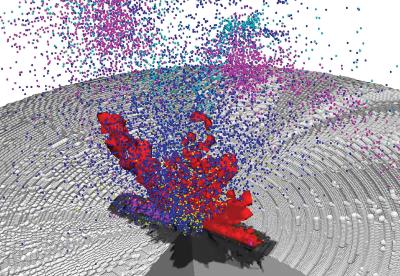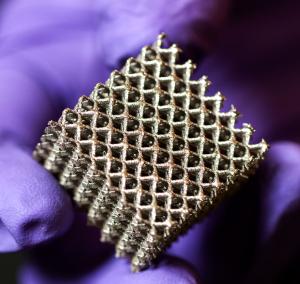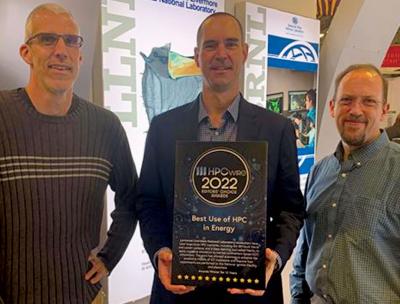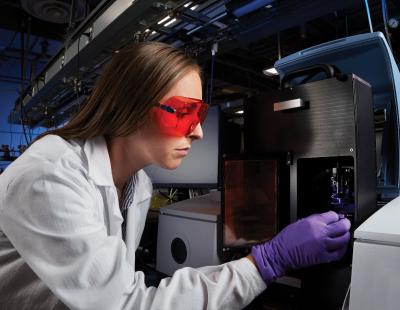Expanding the boundaries of scientific knowledge and advancing the technological state of the art to solve problems of national and global importance
Through its science and technology capabilities, Livermore makes fundamental discoveries about nature, develops innovative technologies that improve life and drive the economy, and carries out its mission to improve national security.
Successful Planetary Defense Test
On September 26, 2022, several Laboratory researchers joined other members of the Double Asteroid Redirection Test (DART) team at the Johns Hopkins Applied Physics Laboratory to watch the 600-kilogram DART spacecraft, traveling at 6 kilometers per second, crash into Dimorphos—the small moonlet that orbits the larger Didymos asteroid. Two weeks after the impact, NASA confirmed that the mission successfully deflected Dimorphos and changed its orbital period around the larger asteroid. Livermore scientists have been working as part of the DART team since mission planning began in 2014. They have contributed to developing and applying multiphysics simulations for planetary defense and, in particular, predicting and analyzing the results of the DART demonstration. The LLNL team is applying machine learning to efficiently evaluate the gathered data and pioneering novel ways of ascertaining the structure of the asteroid’s rubble, simulating the effect of the impact, and analyzing resulting ejecta.
A New Generation of Metal Alloys
A materials scientist at LLNL, along with researchers at Oak Ridge National Laboratory (ORNL) and several universities, created a new class of flexible super-strong metal parts unattainable through traditional metallurgical processing. Using the laser powder bed fusion (LPBF) method, they 3D-printed eutectic alloys—high-entropy alloys or multi-principal elements alloys—that are composed of two main phases and give exceptional strength and ductility. LPBF involves the selective laser melting of metal powder particles, layer by layer, which fuse together to form a larger 3D structure. The new materials were used to build lattice structures and other engineering components. In addition, using multiscale modeling, researchers at LLNL and ORNL recently demonstrated that microscale simulation approaches, when informed by high-fidelity “top-down” simulations, can effectively predict tailored microstructure formation in metals undergoing laser-based additive manufacturing (AM) processes.
The new alloys exemplify LLNL’s state-of-the-art advances in AM of metals and alloys to produce tailor-designed, certifiable, high-precision parts. In addition to creating new materials, Laboratory researchers are exploring the use of surface acoustic waves to characterize surface and sub-surface defects in LPBF metal 3D printing. LLNL researchers also developed real-time diagnostics to distinguish droplet behavior in liquid metal jetting (LMJ) machines that eject tiny molten metal droplets from a nozzle at high speeds to 3D print a part in layers. The compact and non-invasive millimeter-wave diagnostic provides data that can be analyzed to determine whether high-quality drops are being generated and to ensure part quality. Another team is exploring the use of low-frequency, electromagnetic near-field detection to LMJ to capture metal droplet dynamics that, when combined with simulation, provides information on droplet features.
Studying Rare and Toxic Elements
LLNL scientists and collaborators at Oregon State University developed a new method to isolate and study in great detail rare and toxic elements while using very small amounts. Such studies are difficult due to the extreme toxicity of materials, as well as the cost and scarcity of research isotopes. Traditional synthetic methods and chemical studies typically require several milligrams of sample per attempt—for some isotopes, this sample size is equivalent to the world’s yearly supply. The groundbreaking method, which involves heavy polyoxometalate ligands, requires 1,000 times less material than prior state-of-the-art approaches. It enables the simple formation, crystallization, handling, and detailed spectroscopic and structural characterization of complexes containing rare isotopes starting from just 1 to 10 micrograms. Using this method, the team found several new single crystal x-ray diffraction structures, including three new compounds of curium. Just 10 curium complexes had been isolated and characterized by single crystal x-ray diffraction since the discovery of the element in 1944.
Honors for High-Performance Computing
Awards and honors recognized LLNL’s leadership in diverse aspects of high-performance computing (HPC). At the 2022 International Conference for High-Performance Computing, Networking, Storage, and Analysis (SC22), HPCwire named LLNL’s use of cognitive simulation techniques for inertial confinement fusion research (see National Ignition Facility) as its Editor’s Choice for Best Use of HPC in Energy. Also presented at SC22, the latest TOP500 list of the world’s most powerful computer systems includes nine machines at LLNL, led by Sierra, which is ranked #6. Livermore’s SUNDIALS open-source software library was announced as the 2023 winner of the prestigious SIAM/ACM Prize in Computational Science and Engineering. The software suite is internationally recognized as a reliable and effective tool for time-integrating equations that model and simulate physical phenomena. Another honor was a Best Paper award at the 15th IEEE Pacific Visualization Symposium. The “Adaptive Multilinear Meshes” method, developed in collaboration with researchers at the University of Utah, provides users with a versatile tool for reducing the size of large scientific datasets to visualize data and extract information.
Diffraction Gratings Enable More Powerful Lasers
LLNL researchers and their collaborators developed new high-energy, low-dispersion (HELD) multi-layer dielectric gratings that provide a factor of 3.4 performance improvement over the existing state-of-the-art technology. Diffraction gratings prevent damage to optics in powerful lasers by stretching a laser pulse and recompressing it after the pulse has been greatly amplified. HELD will be used in L4-ATON, which is designed to deliver up to 10 petawatts (quadrillion watts) of peak power and will be the world’s highest power laser system when installed at the ELI Beamlines facility in the Czech Republic. L4-ATON will be able to generate 1.5 kilojoules (kJ) of energy in 150-femtosecond (quadrillionths of a second) pulses at a repetition rate of one shot per minute. Multi-petawatt laser technology opens the door to groundbreaking research in areas such as plasma and high-energy-density physics, astrophysics, laser-driven particle acceleration, enhanced medical diagnostics, industrial processing techniques, and nuclear materials detection. The HELD gratings won a 2022 R&D 100 Award (see Partnerships).
Machine Learning Sheds Light on Cancer
A Livermore-led team of scientists developed and are applying a highly detailed, machine learning–backed multiscale model for revealing the importance of lipids to the signaling dynamics of RAS, a family of proteins whose mutations are linked to about a third of all cancers. The nearly 120,000 Multiscale Machine-Learned Modeling Infrastructure (MuMMI) simulations performed on LLNL’s Sierra supercomputer showed how hundreds of RAS proteins interact with eight kinds of lipids. When combined with experiments performed at Frederick National Laboratory for Cancer Research, the work demonstrated a link between lipid composition and RAS orientation in determining binding probability.
Using the Frontier exascale supercomputer at Oak Ridge National Laboratory, an LLNL team will apply the MuMMI computing framework and artificial intelligence to predict how RAS and RAF proteins interact with each other and with lipids on a realistic cell membrane. The ADMIRRAL (AI-Driven Multiscale Investigation of RAS–RAF Activation Lifecycle) project will provide researchers with a better understanding how the proteins mutate and cause tumors to form.
Researchers from LLNL and University of California (UC) at San Francisco used a logistical regression approach to examine a data set containing nearly a half-million patients who underwent COVID-19 testing at all 17 UC-affiliated hospitals. The data set included nearly 50,000 patients with cancer—more than 17,000 of whom also had tested positive for COVID—and contained information on patient demographics, comorbidities, lab work, cancer types, and various cancer therapies. They found that patients with cancers called myeloproliferative neoplasms and those who had been treated with two medications—venetoclax (to treat leukemia) and methotrexate (an immune suppressant used in chemotherapy)—were more likely to be hospitalized after contracting COVID-19.
Solar System Scientific Discovery
Understanding the history of volatile species, such as water, in the Earth–Moon system is a major objective of planetary science. Interestingly, although much of the Earth’s surface is covered with water, overall the planet is relatively dry compared to many other objects in the solar system, and the Moon is even drier. A team of LLNL cosmochemists studied lunar highland rock samples and found only limited ingrowth of strontium–87 from the radioactive decay of volatile rubidium–87. They concluded that the bodies that collided to form the Earth–Moon system had very low levels of volatile species prior to impact. Earth’s relatively small proportion of water is then either primarily indigenous or was added by later impacting sources composed of essentially no volatile elements. The study also revealed that the event known as the “Giant Impact” could not have happened prior to 4.45 billion years ago, greatly reducing the time window of the Moon’s formation. Both bodies must have come from the inner solar system. In another study of isotopic variations in terrestrial and meteoritic samples, LLNL scientists and collaborators concluded that Earth and Mars formed by collisions of planetary embryos originating from the inner solar system—rather than materials drifting in from the outer solar system.
LLNL and NASA’s Goddard Space Flight Center are co-leading Pandora, a small satellite mission to analyze starlight as it passes through the atmosphere of exoplanets. Using a technique called transit spectroscopy, researchers will study about 20 stars with exoplanets and determine atmospheric compositions by observing visible and infrared light as a planet transits in front of its host stars. The challenge is to disentangle the data and determine which variations are due to the exoplanet’s atmosphere and which are due to starspots and other stellar phenomena. The Pandora mission, expected to launch in 2024 or early 2025, is part of NASA’s Astrophysics Pioneers program.
Engineered Materials
LLNL materials scientists are applying additive manufacturing (AM) to make engineered materials with amazing properties. Working with UC Berkeley colleagues, they produced sturdy, complex microstructured glass objects by applying an extension of the team’s breakthrough volumetric AM process. Laser light, rather than light-emitting diodes, is used to illuminate a rotating target made of special resin. The intense light produces a 3D object in seconds with a surface smoothness measured in nanometers. The absence of flaws makes the object much less likely to break. Another research team developed a process to transform fully dense, 3D-printed polymeric beams into graphitic carbon hollow tube-in-tube sandwich structures, where, similar to grass stems, the inner and outer tubes are connected through a network of struts. The resulting structure has high stiffness (nearly proportional to density), large surface area, and large deformation recovery. Porous ultralow-density materials have many emerging applications. LLNL scientists also made award-winning advances in direct ink writing (see Partnerships).
In addition, Laboratory AM researchers pursue research on 4D engineered materials—architected structures that can morph into a particular shape and exhibit new properties when exposed to heat, magnetic or electrical forces, chemical or electrochemical reactions, and mechanical deformations. Examples include shape memory polymers and sentient mechanical logic gates. Potential applications include implantable medical devices, as vehicles for drug delivery, or in autonomous robots.
Cancer Therapies
LLNL scientists are pursuing wide-ranging efforts to improve cancer treatment, such as studying the biology of tumors to devise more targeted therapies and developing new approaches to study, capture, and purify more effective medical isotopes. Researchers are also investigating a revolutionary technology for cancer treatment and a paradigm shift for predictive oncology. A new radiation treatment concept, called FLASH radiotherapy (FLASH-RT), could be used to deliver a precisely targeted, ultrashort, high dose of therapy radiation that selectively kills cancer cells while minimizing damage to healthy cells. FLASH-RT is based on linear induction accelerator technology developed as part of the Laboratory’s Stockpile Stewardship Program. By precisely controlling the magnets in four beamlets placed symmetrically around a patient, a steerable FLASH-RT beam would deliver a nearly instantaneous high dose, which would reduce the patient’s time under radiation.
A grand challenge in cancer therapy is to develop “digital twins”—virtual representations of cancer patients using real-time data. A multi-institutional team, including an LLNL contributor, has proposed a framework for Cancer Patient Digital Twin (CPDT) models. Researchers aim to create a multiscale and multimodal data set from individual patients, as well as clinical trials and population studies. These data will be used to train mechanistic and artificial intelligence models for making treatment predictions and advising individualized health care decisions for cancer patients. CPDTs would also provide policymakers with insights into which cancer therapies show most promise, informing investment and resource allocation decisions. However, there are significant hurdles to overcome before such a model becomes a reality.









